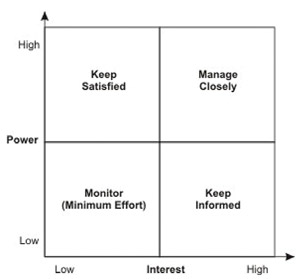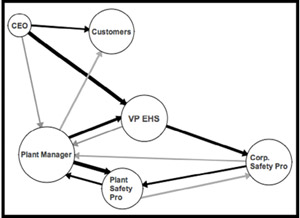How often have you come up with a safety idea and found yourself beating your head against the wall trying to get buy-in?
Dr. Robert B. Cialdini of Arizona State University in his “Influence: The Psychology of Persuasion”1 provides terrific insight into the psychological principles of influencing people and knowing when you are being influenced. Dr. Cialdini calls his principles the Weapons of Influence.
The Weapons of Influence are: 1) Reciprocity, 2) Commitment and Consistency, 3) Social Proof, 4) Authority, 5) Liking and 6) Scarcity. Before embarking on using any one or several of these influencing principles, make sure you understand the individual you want to influence, the circumstances of the situation, and why you want to influence this individual. Here is a brief description of each with an example.

|
|
Figure 1: Power/Interest Grid for Stakeholder Prioritization |
Choose your weapon
Reciprocity deals with some form of payback. You have done something for someone or vice versa and that person or you feel an obligation to return the favor. Sarah is under a severe deadline to deliver a report on safety incident learnings for the past year to the corporate VP of safety. Sarah recalls all the additional work she has done for her fellow safety colleague Ron, so she approaches Ron and asks for his help. Ron says he is too busy, so Sarah reminds Ron of how she has helped him in the past. Ron realizes he may not be able to count on Sarah in the future to help him, so agrees to help her.
Commitment and Consistency focuses on the desire to be consistent over time. Phil saw an opportunity to reduce workers’ compensation costs. Rather than presenting it to his boss, he ran his idea by a number of colleagues to solicit their input and gain their support. By the time Phil was ready to present it to his boss, he had key individuals on-board, and all felt they were a part of the idea development and wanted to see it succeed.
Social Proof involves individuals becoming active because a number of other people are involved. Since Dave involved most of the industrial hygiene staff, Richard and Mary, who were not initially involved, asked Dave if they could become involved. Richard and Mary realized they did not want to be left out of the group.
Authority is used when people feel a sense of obligation to their supervisor. Michael, the VP of Safety, recently returned from an ASSE workshop on leading safety metrics and asked Jack to implement a new leading safety metrics initiative. Even though Jack isn’t a fan of leading safety metrics, he launched the new program based on who asked him to do it.
Liking obviously is about whether others like you or not. This can be manifested in friendships or simply having respect for someone, even though you may not know them. Over the years, Barbara had established a number of friendships throughout the organization. During the course of a serious accident investigation, Barbara was able to count on the trust she had built with the involved parties to identify the underlying systemic causes of the accident, which were being withheld.
Scarcity deals with the limited supply of something. According to Dr. Cialdini, people are more driven by what they might lose versus what they might gain. At the executive staff meeting, the CEO informed her staff that incentive compensation would have to be cut dramatically at year-end if costs could not be reduced. Sarah, the VP of EHS, realized that historically her function did not offer much in cost reductions. Rather than do nothing and probably forfeit her and her staff’s incentive compensation, she met with her leadership team and honestly told them about the impending loss. Together they mapped out a strategy to not only reduce the EHS function costs, but also assist operating groups in lowering their EHS costs.

|
| Figure 2 |
Weapons of Influence can certainly be used in a manipulative fashion, and often are, to persuade you to buy something (e.g., a car) or act in a certain way (e.g., voting). Dr. Cialdini cautions against manipulation. Trust takes time to build but can be lost in the blink of an eye.
Who has the power and the interest?
Now that you know the Weapons of Influence, how do you determine on whom to use this new knowledge? James Manktelow and Rachel Thompson2 offer several tools to determine who has the influence over your projects and work and how you should manage your relationships with these individuals.
Rachel Thompson describes the Stakeholder Analysis3 tool, which is used to determine who are the key people you need to win over for your project to succeed. The first step involves identifying your stakeholders. For example, identify the stakeholders according to the company (e.g., your boss, your coworkers, customers), shareholders (e.g., suppliers, lenders, analysts), and government (e.g., agencies, trade associations, press, community). Step two focuses on prioritizing your stakeholders according to the Power/Interest Grid. Where do your stakeholders fall in this grid?
Cold, hard assessments
The third step involves understanding your key stakeholders. Key questions can help you understand your stakeholders:
• What financial or emotional interest do they have in the outcome of your work? Is it positive or negative?
• What motivates them most of all?
• What information do they want from you?
• How do they want to receive information from you? What is the best way of communicating your message to them?
• What is their
current opinion of your work? Is it based on good information?
• Who influences their opinions generally and who influences their opinion of you? Do some of these influencers therefore become important stakeholders in their own right?
• If they are not likely to be positive, what will win them around to support your project?
• If you don’t think you will be able to win them around, how will you manage their opposition?
• Who else might be influenced by their opinions? Do these people become stakeholders in their own right?
Discover the true power players
MindTools.com provides the next step for creating an Influence Map4. Influence mapping helps you to discover who has the power, which may or may not be the normal chain-of-command. There are three main considerations to take into account:
1. The importance or weight of a stakeholder’s overall influence, which is represented by the size of the circle.
2. The relationships between stakeholders, which is represented by lines and arrows between them.
3. The amount of influence stakeholders have over others, which is represented by the heaviness of the lines drawn between them.
Here is a simple example. You are a corporate safety professional and your VP assigns you with introducing a new plant safety initiative, which is strongly supported by the CEO. Initially, you think the CEO has the most influence on this project, but once you conduct your stakeholder analysis and create an influence map, you realize the plant manager has the most influence. In addition, the plant safety professional, who you have not gotten along with for years even though you have had influence over her, is going to play a very influential role in the success of your endeavor. Now that you know whose support you need, which weapon of influence would you use, and how and when would you use it?
In closing, I encourage you to visit MindTools.com for a plethora of tools that will make your career a tremendous success.
References
1 Cialdini, R.B. 2006. Influence: The Psychology of Persuasion. HarperCollins Publishers. NY, NY.
2 MindTools.com. James Manktelow and Rachel Thompson. July 11, 2011. Newsletter 198. http://www.mindtools.com/pages/Newsletters/12Jul11.htm#New3
3 Thompson, R. Stakeholder Analysis – Winning support for your projects. http://www.mindtools.com/pages/article/newPPM_07.htm
4 MindTools.com. James Manktelow and Rachel Thompson. Influence Maps – Uncovering where the power lies in your projects. http://www.mindtools.com/pages/article/newPPM_83.htm




